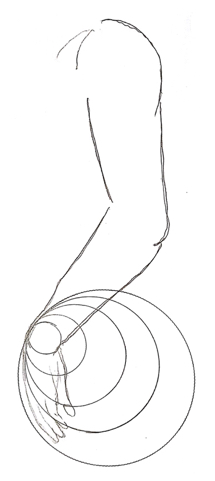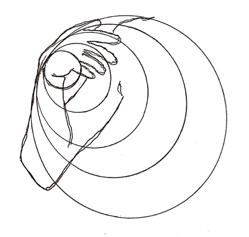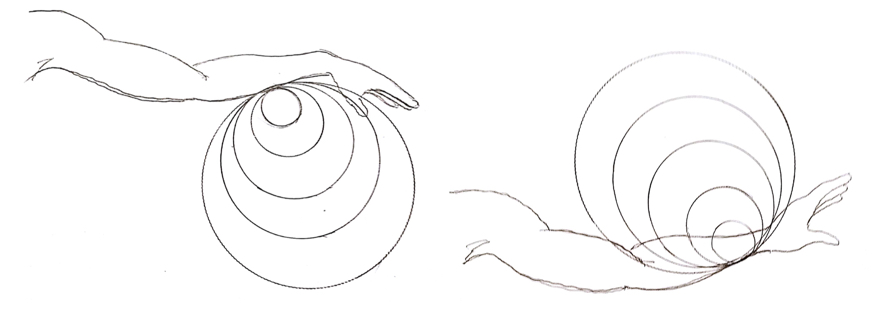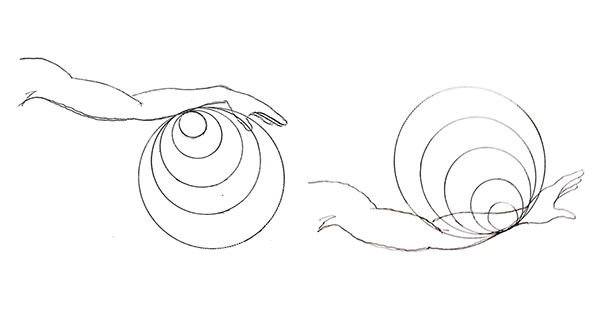 If one is standing in a form’s beginning posture, one can imagine an opponent contacting the backs of your wrists as you begin to raise your arms. There can be an infinite number of imaginary circles/spheres all touching the point of contact with the opponent, some of which are shown in the drawing (only one arm is shown). Note that each size circle has a different center.
If one is standing in a form’s beginning posture, one can imagine an opponent contacting the backs of your wrists as you begin to raise your arms. There can be an infinite number of imaginary circles/spheres all touching the point of contact with the opponent, some of which are shown in the drawing (only one arm is shown). Note that each size circle has a different center.
If one merely wants to grab the opponent, a small circle/sphere that pivots one’s “tiger’s mouth” (the place between the thumb and index finger) up to contact the opponent’s wrist can be used. If one wants to raise their arm to elbow height, then a larger circle/sphere will be used; if up to shoulder height, then an even larger circle/sphere will be used. Since the various sizes of circles/spheres all meet at the same contact point, any size circle/sphere can be chosen and would depend on one’s desired action.
 Switching from one size circle/sphere to another is also possible due to them all contacting the opponent at the same point. A compound example can be illustrated with the Chen style opening where a small circle in front of the body transitions into a large one towards one’s left.
Switching from one size circle/sphere to another is also possible due to them all contacting the opponent at the same point. A compound example can be illustrated with the Chen style opening where a small circle in front of the body transitions into a large one towards one’s left.
Another common example in Taijiquan practice is “embracing” a ball in front of the torso. This is one large sphere that both arms embrace. But we know that both arms have a degree of independence and are not fixed to just that one sphere’s size. So, one could also view this posture as both arms embracing separate spheres. The accompanying drawing shows how numerous spheres (shown as circles) can be envisioned for one of the two arms (note that the contact point with an opponent would be on the back of the wrist where all of the circles touch).
Note that the circles/spheres can be anywhere that the opponent contacts you, like in the drawing shown below where the contact shown is underneath the forearm. Depending on the intent and the direction of movement/rotation, the circles/spheres can be above or below (or to the sides of) the point of contact. Note also how the angle of the wrist can change the energy to complement the desired circle/sphere. In the left drawing, the energy would primarily be one of absorbing the contact below the forearm, whereas the drawing on the right illustrates primarily projecting towards the contact below the forearm.

With multiple circles/spheres, one can coordinate multiple points of contact into one combined circle/sphere, or one can divide them into separate circle/spheres. The division into separate circles/spheres is what allows one to apply torque when applying lie (挒torque or splitting), one of the eight jin(勁refined power)of Taijiquan. One circle/sphere provides primarily the push (yang) and another provides primarily the pull (yin) energies for the lie application.
One can have multiple circles/spheres simultaneously, commonly moving in different directions and at different speeds, each with its own center of rotation. While each joint has its own movements, they coordinate together within the larger unified spheres, like multiple balls of different sizes that each influences any others that are in contact, or that are strung together. Some are within others, some contact others, and some act independently from others.

Leave a Reply